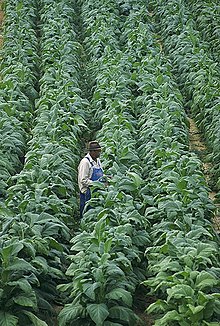Plantation economy
| Part of a series on |
| Economic systems |
|---|
|
Major types
|
A plantation economy is an economy which is based on agricultural mass production, usually of a few staple products grown on large farms called plantations. Plantation economies rely on the export of cash crops as a source of income. Prominent plantation crops have included cotton, rubber, sugar cane, tobacco, figs, rice, kapok, sisal and indigo.
Regions with plantation economies have usually been in the southern United States, South America, the Caribbean, and Africa. Fordlândia is a 20th century example[citation needed] of a plantation economy. Plantation economies are also historically associated with slavery, particularly in the United States. Plantation economies usually benefit the large countries to which they are exporting, which usually manufacture the raw materials grown on the plantations into goods which are then traded back to the plantation economy. Throughout most of history, the countries receiving the crops have usually been in Western Europe.
Tobacco and Virginia economy
Tobacco production was labor intensive and required thousands of slaves. The wealth and Influence of the so-called "tuckahoe" Virginia planters depended on tobacco. The production of tobacco spread down the James, York, Rappahannock, and the Potomac rivers.
Over the years tobacco became important in Virginia’s economy, even acting as currency in an economy where the species was scarce. An independent currency allowed the colonies to gain power and slowly break away from the British economically and culturally. In the year 1758 Virginia exported 70,000 hogsheads of tobacco. The production of tobacco in colonial times required much toil. The plants had to be grown from seeds in a cold frame, set out, weeded, tasseled, harvested, and cured. All of this work was done by man and beast. Each acre produced about 5,000 plants that required hand care over and over again. But, with slave labor, profits exceeded any other plant that could be grown.[1]
Many of the wealthy and influential men in Colonial Virginia were Planters; tobacco plantation owners. A number of America's first presidents owned slaves. They owned numerous plantations, each with large numbers of slaves.
Slave statistics
In the year 1860, one out of every four families in Virginia owned slaves. The figures cited here are from the 1860 census. There were over 100 plantation owners that owned over 100 slaves.[2]
- Number of slaves in the Lower South : 2,312,352 (47% of total population).
- Number of slaves in the Upper South: 1,208,758 (29% of total population).
- Number of slaves in the Border States: 432,586 (13% of total population).
Fewer than one-third of all Southern families owned slaves at the peak of slavery prior to the Civil War. In Mississippi and South Carolina it approached one half. The total number of slave owners was 385,000 (including, in Louisiana, some free Negroes), amounting to approximately 3.8% of the Southern and Border states population.

On a typical plantation of more than 20 slaves, the capital value of the slaves was greater than the capital value of the land and implements.
Sugar plantations
Sugar has a long history as a plantation crop. Growing had to follow a precise, scientific system in order to profit from the production. Sugar plantations everywhere were disproportionate consumers of labor -- often enslaved -- owing to the high mortality of the plantation laborers.
The slaves working the sugar plantation were caught in an unceasing rhythm of arduous labor year after year. Sugarcane is harvested about 18 months after planting and the plantations usually divided their land for efficiency. One plot was lying fallow, one plot was growing cane, and the final plot was being harvested. During the May-December rainy season, slaves planted, fertilized with animal dung, and weeded. From January to June, they harvested the cane by chopping the plants off close to the ground, stripping the leaves, then cutting them into shorter strips to be bundled off to be sent to the mill.
In the mill, the cane was crushed using a three roller mill. The juice from the crushing of the cane was then boiled or clarified until it crystallized into sugar. Some plantations also went a step further and distilled the molasses (the liquid left after the sugar is boiled or clarified) to make rum. The sugar was then shipped back to Europe, and for the slave laborer the routine started all over again.
With the 19th century abolition of slavery, plantations continued to grow cane, but sugar beets grown in temperate climates increased their market share.
Indigo plantations
Indigofera was a major crop of cultivation during the colonial period, in Haiti until the slave rebellion against France that left them embargoed by Europe, Guatemala in the 18th century and India in the 19th and 20th centuries. The indigo crop was grown for making blue indigo dye in the pre-industrial age. Mahatma Gandhi's investigation of indigo workers' claims of exploitation led to the passage of the Champaran Agrarian Bill in 1917 by the British colonial government.
See also
- Banana republic
- History of commercial tobacco in the United States
- History of sugar
- Tropical agriculture
- Zanj Rebellion
- Plantation aristocrat
References
- ^ "Tobacco in Virginia". Retrieved 2006-03-24.
- ^ "PBS The Slaves' Story". Retrieved 2006-03-24.
